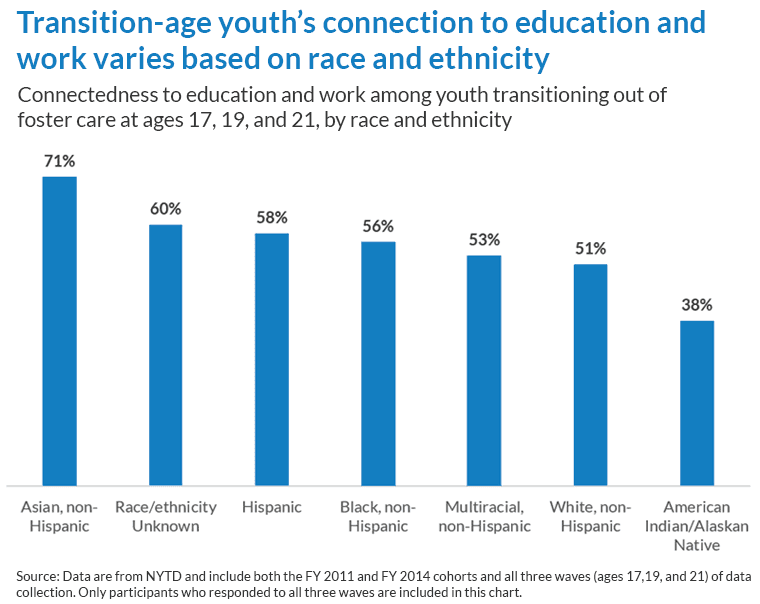For more information on the National Youth in Transition Database (NYTD)—and on what NYTD data can tell researchers, policymakers, and other stakeholders about the experiences and well-being of older youth in foster care as they transition to adulthood—click here.
Nearly 18,000 young people aged out of the foster care system in fiscal year (FY) 2018. In other words, the child welfare system failed to reunify these young people with their parents or find them another legal, permanent placement through adoption or guardianship. Relative to their peers in the general population, young people who age out of foster care often experience lower levels of educational attainment and higher levels of unemployment or underemployment. For all young people, education and employment play an important role in their healthy transition to adulthood. Our new analysis reinforces what existing research has found: When young people receive educational aid and employment skills training, and other necessary services, they are more likely to be connected to employment and/or school.
Educational attainment is directly linked to young people’s future earning potential. Prior research indicates that young people with foster care experience who have a high school diploma or GED are twice as likely to be employed as those without these credentials, and that those with some college experience are more than three times as likely to be employed. It is developmentally appropriate for young people ages 18 to 21 (both within the general population and those with foster care experience) to either be enrolled in school or employed, but not necessarily both. However, examining education and employment outcomes separately does not allow researchers to capture the positive outcome of being either in school or working—which may be a more common outcome for young people than being both employed and in school. Indeed, in a recent study of youth in or transitioning from foster care, more than half were employed or in school but close to one third were neither enrolled in school nor employed.
Employment and education support can ease the transition to adulthood
In the recent National Youth Transition Database (NYTD) report to Congress, young people transitioning out of foster care at ages 17, 19, and 21 reported low rates of employment and educational attainment. Only one third of young people reported being employed at age 21,[1] despite 70 percent reporting a high school diploma or GED. The report also jointly examined education and employment in one “readiness” category (defined as having a high school diploma/GED or higher and either being enrolled in school or employed by age 21). The report compares youth deemed “ready” at age 21 with those considered “not ready,” showing differences in those who are young parents (21% vs. 32%), incarcerated (11% vs. 27%), and homeless (21% vs. 34%).
Young people who received educational financial aid[2] were more likely to be connected to employment and/or school across all time points. While the NYTD report examined readiness at one time point (age 19 or age 21), our analysis examines how employment and education outcomes are connected over time (connection at ages 17, 19, and 21), and explores differences in these outcomes by race/ethnicity. Our analysis includes young people in the two currently available NYTD cohorts (FY 2011 and FY 2014) who responded to all three waves of the NYTD survey. Three quarters of young people who received educational aid were connected[3] to education and/or employment at all three time points, compared to 41 percent of respondents who did not receive educational aid. Additionally, 59 percent of young people who reported receiving employment skills training[4] were connected at all three time points, compared to 47 percent of young people who did not report receiving employment skills training.
We found differences in connection to work and/or school at age 21 by race or ethnicity, gender, and young parenthood. There were disparities by race/ethnicity, with Asian non-Hispanic young people being the most connected and American Indian/Alaskan Native non-Hispanic young people being the least connected (71% and 38%, respectively). Young parents were less connected than non-parents (43% and 58%, respectively), and men experienced connection slightly less often than women (52% and 55%, respectively). To contextualize these findings, we must consider the policies and structures that drive disparities in education and employment, such as access to and availability of post-secondary education and workforce training, school funding mechanisms, and reliance on standardized testing for grade advancement.
Related Content
- Better Data on Homelessness Needed as Young Adults with Foster Care Experience Transition to Adulthood
- Transition to Adulthood: What We Know (and What We Don’t) about Young People with Foster Care Experience from the National Youth in Transition Database (NYTD)
- Young People and Advocates Use NYTD Data to Shape Policy and Practice

The picture is incomplete, but education and training seem to boost outcomes
While our analysis of employment and education connections across several time points (ages 17, 19, and 21) provides a better picture of the needs of young people transitioning out of foster care than has previously existed, it is nevertheless incomplete. Small sample sizes and low NYTD response rates are limitations of these findings; while we should consider them to be important factors within conversations about equity in outcomes, we should also remember the caveat that further research is needed. Additionally, the definitions of educational aid and employment skills are not comprehensive, leaving room for interpretation and inconsistencies across states, as well as potential variations in understanding and reporting among young people who respond to the survey.
Young people in and transitioning out of foster care need consistent, ongoing support via educational and employment skills, training, and resources. Increasing access to programs and services that boost educational attainment, employment, and earnings can allow young people to thrive in adulthood. And given the differences in outcomes across races and ethnicities, the child welfare system should consider culturally responsive and appropriate services that are targeted at reducing racial and ethnic disparities.
Footnotes
[1] NYTD surveys all young people who were in care during the baseline year and 17 years old. Those youth receive follow-ups at ages 19 and 21, regardless of their involvement with extended foster care.
[2] Educational aid is a scholarship, voucher, grant, stipend, student loan, or other type of educational financial aid.
[3] Connection includes full- or part-time employment, or current enrollment in school of any sort (high school, vocational program, two- or four-year college).
[4] Employment-related skills include an apprenticeship, internship, or other on-the-job training, either paid or unpaid, in the past year.
© Copyright 2025 ChildTrendsPrivacy Statement
Newsletter SignupLinkedInYouTubeBlueskyInstagram

